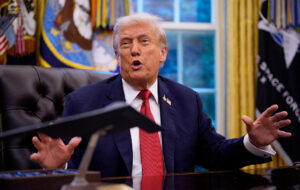Trump moves to ease car tariffs as the auto industry sounds alarm – what it means for American consumers is now shaping major economic conversations across the United States. The Trump administration’s latest policy shift, announced on April 28, 2025, is being seen as a smart move to prevent steep car price increases, protect millions of auto jobs, and sustain America’s critical manufacturing sector.
Understanding the Decision: Why Trump Eased Car Tariffs
To fully grasp the significance of this move, it’s essential to understand the root cause. Initially, the administration planned to impose a 25% tariff on all imported cars and parts, aiming to boost domestic manufacturing. However, a wave of backlash from U.S. automakers, dealerships, and even consumer rights groups forced a reconsideration.
Instead of a flat tariff that would have affected every car buyer, the Trump administration is now allowing certain key components to be exempt, helping automakers maintain production while avoiding sudden price hikes for American families.
Key Adjustments:
- Tariffs reduced for vital car parts imported for domestic manufacturing.
- Flexibility granted to auto companies to adapt their supply chains.
- No stacking of multiple tariffs (cars, steel, aluminum) on the same goods.
This strategic easing protects both American workers and American wallets.
Trump’s Car Tariff Policy Shift at a Glance
Trump Eases Car Tariffs
│
├── Original Plan: 25% Flat Tariff
│ └── Expected $2,500–$5,000 price hikes
│
├── Industry Response: Strong Backlash
│ └── Automakers, dealerships, consumers oppose
│
├── New Plan: Targeted Tariff Relief
│ ├── Key parts exempted
│ ├── Incentives for domestic manufacturing
│
└── Impact on America
├── Lower car prices
├── Preserved auto jobs
└── Strengthened manufacturing sector
Impact on American Car Buyers: Lower Prices, More Choices
What does this policy change mean if you are planning to buy a car?
Without the tariff changes, new cars were projected to cost up to $5,000 more by mid-2025. Today, because of the tariff relief:
- New vehicle prices are expected to stay within normal inflation trends.
- Loan terms will remain accessible, protecting consumer purchasing power.
- More choices will stay available as manufacturers avoid cutting model lines.
Important Data Point:
According to the Center for Automotive Research, even a 10% increase in car prices could have priced up to 2.5 million American households out of the new car market.
How U.S. Auto Manufacturers Benefit from Tariff Relief
Automakers such as Ford, GM, and Tesla heavily rely on international supply chains for essential components like computer chips, transmissions, and electronics. Completely localizing the supply chain overnight is impractical.
By easing tariffs:
- U.S. factories can continue operations without immediate massive cost hikes.
- Companies have more time to invest in American-based production plants.
- American assembly line workers, many in the Midwest and South, can keep their jobs.
Job Impact Fact:
The U.S. auto industry supports more than 10 million jobs across assembly, parts manufacturing, dealerships, and service sectors.
Trump’s Original vs New Car Tariff Plan
| Feature | Original Tariff Plan | Eased Tariff Plan |
|---|---|---|
| Tariff Rate | 25% flat on all imports | Relief for essential parts |
| Effect on Car Prices | +$2,500–$5,000 per car | Minimal price rise |
| Industry Reaction | Strong opposition | Cautious support |
| Supply Chain | Immediate disruption | Gradual adjustment allowed |
| Consumer Impact | Major price hikes | Stability for buyers |
Broader Economic Effects: Beyond Just Car Prices
This decision is about more than just the automotive sector. It reflects broader lessons in trade policy:
- Globalization is deeply rooted even in industries seen as American.
- Economic ripple effects (lost jobs, higher costs) can outweigh political gains.
- Consumers ultimately bear the cost of trade wars if not carefully managed.
In easing car tariffs, the Trump administration is attempting to strike a balance between encouraging domestic production and maintaining economic stability for millions of American households.
The Road Ahead: What American Consumers Should Watch For
The tariff easing is a temporary measure, not a permanent fix. Here’s what U.S. consumers and businesses need to monitor in the coming months:
- Future trade negotiations: Will a more comprehensive agreement be reached?
- Shift in supply chains: Will automakers move more manufacturing to U.S. soil?
- Price monitoring: Will car prices stay stable through 2025 and beyond?
The success of this policy will ultimately depend on its implementation and the flexibility shown by automakers and suppliers alike.
Conclusion: Trump’s Tariff Easing is a Win — But Only for Now
Trump’s decision to ease car tariffs after intense industry alarm has, for now, averted a major economic setback. It protects millions of jobs, prevents steep price hikes, and buys critical time for the U.S. auto sector to adjust its strategies.
While not a permanent solution, it reflects a pragmatic approach that prioritizes both economic strength and consumer protection.
Going forward, both automakers and American car buyers must stay vigilant as trade dynamics continue to evolve.
Key Stats to Remember:
- Potential $2,500–$5,000 in car price savings protected.
- Over 10 million American jobs supported.
- Global supply chain complexity acknowledged by policymakers.
For consumers, this means a more stable car-buying environment — at least for now.
[USnewsSphere.com / reu.]





